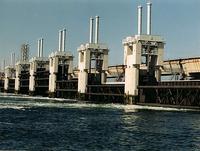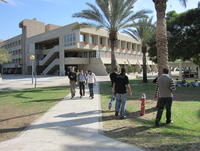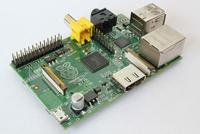-
Cities seek new ways to cope with sea level rise – and look to the Dutch for advice

Scientists predict a “tenfold increase” in the frequency of hurricanes and other storms, as well as sea-level rise of eleven to twenty-four inches within a little more than three decades – and planners and managers in U.S. coastal cities are looking at new ways to prepare their cities’ infrastructure for these challenges. In New York and New Orleans, city planners are studying the experience of the Dutch, who have gained a lot of experience – and fame — for their water control methods.
-
-
R&D at DHS is “inherently fragmented”: GAO
The GAO says that DHS does not know how much it spends on R&D, making it difficult for the sprawling agency to oversee and coordinate those efforts. David Maurer, GAO’s director of Homeland Security and Justice, told a House hearing that R&D at DHS is “inherently fragmented.” The reason is that each of several components of the agency — the Science and Technology Directorate, the Coast Guard, and the Domestic Nuclear Detection Office — are given R&D responsibilities by law. At the same time, other DHS components conduct their own R&D efforts as long as those activities are coordinated through the S&T office, Maurer said.
-
-
Rural towns lose to urban centers in competition for coastal protection funding
Infrastructure protection planners say there are only three ways coastal communities can defend themselves against rising sea levels: defend the shoreline with both natural and man-made barriers; raise key infrastructure such as buildings and roads; or retreat from the shoreline. Each of these options costs a fortune to follow. Smaller, more rural coastal communities in many states are finding that they are having a hard time competing with more powerful interests in coastal urban cities over funding for protection against sea-level rise.
-
-
$5 million for new cybersecurity building at Ben-Gurion University of the Negev

Ben-Gurion University of the Negev (BGU) is a central component of the new “CyberSpark” initiative, a multi-component cyber eco-system. It is the only complex of its type in the world which is a government-academic-industry partnership and includes Fortune 500 companies and cyber-incubators, academic researchers and educational facilities, as well as national government and security agencies. A $5 million contribution will underwrite construction of the building that will house the Cyber Security Institute.
-
-
Cheap, easy-to-install water purifying system for remote communities
About 1.5 million people — and 90 percent of them children — die every year from consuming untreated or contaminated water. University of Adelaide mechanical engineering students and staff have designed a low-cost and easily made drinking water treatment system suitable for remote communities in Papua New Guinea (PNG) — using foil chip packets and some glass tubing.
-
-
Kickstarter-funded video game teaches kids how to code
Computer scientists have successfully funded on Kickstarter a new and improved version of CodeSpells, a first-person player game they developed that teaches players how to code. The game’s previous iteration has been in use in dozens of schools throughout the world for more than a year. The researchers have been using the game as a platform to learn about the best ways to teach children how to code.
-
-
Inexpensive, home-made quake early-warning system can be a life saver

UC Berkeley astrophysics professor Josh Bloom has developed an earthquake early-warning (EEW) device meant for the home or office. Resembling a home fire alarm or carbon monoxide sensor, the device was built using a Raspberry Pi single-board computer, an SD card, wired power speaker, and mini Wi-Fi adapter — costing roughly $110 in parts.
-
-
Florida Keys preparing for rising sea levels
The Florida Keys rank third among East Coast communities at risk of “population displacement” due to higher seas which will flood nearby land. Scientists say that if sea levels continue to rise at the current rate, high waters which drowned the Keys during 2005’s Hurricane Wilma could become a normal part of living in Monroe County by 2060. Officials in Monroe County, Florida are putting together a GreenKeys Sustainability Action Plan which will help residents of the Florida Keys maintain a sustainable lifestyle while under threat of sea-level rise due to climate change.
-
-
Sun-powered desalination for villages in India
Around the world, there is more salty groundwater than fresh, drinkable groundwater. For example, 60 percent of India is underlain by salty water — and much of that area is not served by an electric grid that could run conventional reverse-osmosis desalination plants. MIT researchers show that a different desalination technology called electrodialysis, powered by solar panels, could provide enough clean, palatable drinking water to supply the needs of a typical village.
-
-
DHS lost track of thousands of foreign students in U.S.
The Department of Homeland Security (DHS) has lost tabs on more than 6,000 foreign students who had entered the United States on student visas which have since expired — effectively vanishing without a trace. One of the major problems relating to student visas is the fact that the U.S. government continues to grant schools the power to accept overseas applications even if the schools have not been accredited by the state and have little academic and administrative oversight.
-
-
New device improves radiation detection
In a move that could have important implications for national security, researchers have created a very sensitive and tiny detector that is capable of detecting radiation from various sources at room temperature. The detector is eight to nine orders of magnitude —100 million to as high as 1 billion — times faster than the existing technology. The researchers sought to utilize the exceptional electronic carrier properties of graphene to create the photo detector device. Graphene is made of carbon atoms that are arranged in a honeycomb-like geometrical structure (the diameter of a human hair is 300,000 times thicker than a two-dimensional sheet of graphene).
-
-
Malawi app teaches U.K. school children eighteen months of math in six weeks
Psychologists have found that an app designed to boost the education of children in Malawi has also proved to be a highly effective learning tool for U.K. primary schoolchildren. The study has found that in just six weeks of using the math app on personal tablets in the classroom, children made as much progress as would be expected in twelve to eighteen months of class teaching.
-
-
New Orleans creates economic value out of environmental vulnerability
Following the devastation of Hurricane Katrina in 2005, New Orleans and the state of Louisiana have become so adept at dealing with disaster reconstruction, that their new-found skills are now seen as an economic asset to be shared, for profit, with other states and localities. The area’s new environmental awareness is also a source of economic growth, as analysts now consider “emerging environmental” as one of six key industries in the city and state to focus on development, along with coastal restoration and water management, disaster mitigation and management, hazardous waste disposal, advanced bio fuels and waste water treatment.
-
-
Officials increasingly worried about 3-D-printed gun technology
State and local government officials are debating how to address the growing accessibility of 3-D-printed gun technology. Recent actions by government agencies have signaled that officials are concerned about the increasing availability of printed guns. In December of last year, the U.S. Senate extended the Undetectable Firearms Act for an additional ten years. Additionally, municipalities such as Philadelphia have also moved to ban 3-D-printed guns on the local level. Yet, despite these measures, the technology continues to proliferate.
-
-
NIH launching human safety study of Ebola vaccine candidate
The National Institute of Allergy and Infectious Diseases (NIAID), part of the National Institutes of Health (NIH), will this week begin initial human testing of an investigational vaccine to prevent Ebola virus disease. The early-stage trial will begin initial human testing of a vaccine co-developed by NIAID and GlaxoSmithKline (GSK) and will evaluate the experimental vaccine’s safety and ability to generate an immune system response in healthy adults. The study is the first of several Phase 1 clinical trials that will examine the investigational NIAID/GSK Ebola vaccine and an experimental Ebola vaccine developed by the Public Health Agency of Canada and licensed to NewLink Genetics Corp.
-
More headlines
The long view
New Technology is Keeping the Skies Safe
DHS S&T Baggage, Cargo, and People Screening (BCP) Program develops state-of-the-art screening solutions to help secure airspace, communities, and borders
Factories First: Winning the Drone War Before It Starts
Wars are won by factories before they are won on the battlefield,Martin C. Feldmann writes, noting that the United States lacks the manufacturing depth for the coming drone age. Rectifying this situation “will take far more than procurement tweaks,” Feldmann writes. “It demands a national-level, wartime-scale industrial mobilization.”
How Artificial General Intelligence Could Affect the Rise and Fall of Nations
Visions for potential AGI futures: A new report from RAND aims to stimulate thinking among policymakers about possible impacts of the development of artificial general intelligence (AGI) on geopolitics and the world order.
Smaller Nuclear Reactors Spark Renewed Interest in a Once-Shunned Energy Source
In the past two years, half the states have taken action to promote nuclear power, from creating nuclear task forces to integrating nuclear into long-term energy plans.
Keeping the Lights on with Nuclear Waste: Radiochemistry Transforms Nuclear Waste into Strategic Materials
How UNLV radiochemistry is pioneering the future of energy in the Southwest by salvaging strategic materials from nuclear dumps –and making it safe.
Model Predicts Long-Term Effects of Nuclear Waste on Underground Disposal Systems
The simulations matched results from an underground lab experiment in Switzerland, suggesting modeling could be used to validate the safety of nuclear disposal sites.
